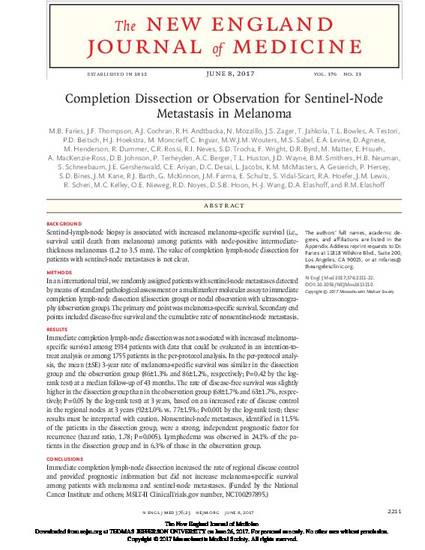
BACKGROUND: Sentinel-lymph-node biopsy is associated with increased melanoma-specific survival (i.e., survival until death from melanoma) among patients with node-positive intermediate-thickness melanomas (1.2 to 3.5 mm). The value of completion lymph-node dissection for patients with sentinel-node metastases is not clear.
METHODS: In an international trial, we randomly assigned patients with sentinel-node metastases detected by means of standard pathological assessment or a multimarker molecular assay to immediate completion lymph-node dissection (dissection group) or nodal observation with ultrasonography (observation group). The primary end point was melanoma-specific survival. Secondary end points included disease-free survival and the cumulative rate of nonsentinel-node metastasis.
RESULTS: Immediate completion lymph-node dissection was not associated with increased melanoma-specific survival among 1934 patients with data that could be evaluated in an intention-to-treat analysis or among 1755 patients in the per-protocol analysis. In the per-protocol analysis, the mean (±SE) 3-year rate of melanoma-specific survival was similar in the dissection group and the observation group (86±1.3% and 86±1.2%, respectively; P=0.42 by the log-rank test) at a median follow-up of 43 months. The rate of disease-free survival was slightly higher in the dissection group than in the observation group (68±1.7% and 63±1.7%, respectively; P=0.05 by the log-rank test) at 3 years, based on an increased rate of disease control in the regional nodes at 3 years (92±1.0% vs. 77±1.5%; P
CONCLUSIONS: Immediate completion lymph-node dissection increased the rate of regional disease control and provided prognostic information but did not increase melanoma-specific survival among patients with melanoma and sentinel-node metastases. (Funded by the National Cancer Institute and others; MSLT-II ClinicalTrials.gov number, NCT00297895 .).
Available at: http://works.bepress.com/dave-hoon/325/

This article has been peer reviewed. It is the author’s final published version in New England Journal of Medicine
Volume 376, Issue 23, June 2017, Pages 2211-2222.
The published version is available at DOI: 10.1056/NEJMoa1613210. Copyright © Massachusetts Medical Society.